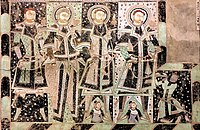 | |
| Location | Xinjiang, China |
|---|---|
| Coordinates | 41°47′30″N 82°53′55″E / 41.791667°N 82.898611°E |
The Kizilgaha Caves (simplified Chinese: 克孜尔尕哈石窟; traditional Chinese: 克孜爾尕哈石窟; pinyin: Kèzīěrgǎhā shíkū) consist in a Buddhist Temple inside a complex of caves in the area of Kucha, Xinjiang, China. The paintings in the cave go back to the 5th century CE.[1] Other famous sites nearby are the Ah-ai Grotto, Kizil Caves, Kumtura, Subashi Temple and the Simsim caves.[2]
Gallery[edit]
-
Kizilgaha beacon tower
-
Donors in Tocharian clothing, Kizilgaha cave 14, Kucha
-
Donors in Tocharian clothing, Kizilgaha, cave 30.
References[edit]
- ^ Yamauchi, Kazuya; Taniguchi, Yoko; Uno, Tomoko; Conservation, Japan Center for International Cooperation in (2007). Mural Paintings of the Silk Road: Cultural Exchanges Between East and West : Proceedings of the 29th Annual International Symposium on the Conservation and Restoration of Cultural Property, National Research Institute for Cultural Properties, Tokyo, January 2006. Archetype. p. 35. ISBN 978-1-904982-22-7.
- ^ (Other than Kizil)... "The nearby site of Kumtura contains over a hundred caves, forty of which contain painted murals or inscriptions. Other cave sites near Kucha include Subashi, Kizilgaha, and Simsim." in Buswell, Robert E.; Lopez, Donald S. (24 November 2013). The Princeton Dictionary of Buddhism. Princeton University Press. p. 438. ISBN 978-1-4008-4805-8.



Well, that’s interesting to know that Psilotum nudum are known as whisk ferns. Psilotum nudum is the commoner species of the two. While the P. flaccidum is a rare species and is found in the tropical islands. Both the species are usually epiphytic in habit and grow upon tree ferns. These species may also be terrestrial and grow in humus or in the crevices of the rocks.
View the detailed Guide of Psilotum nudum: Detailed Study Of Psilotum Nudum (Whisk Fern), Classification, Anatomy, Reproduction